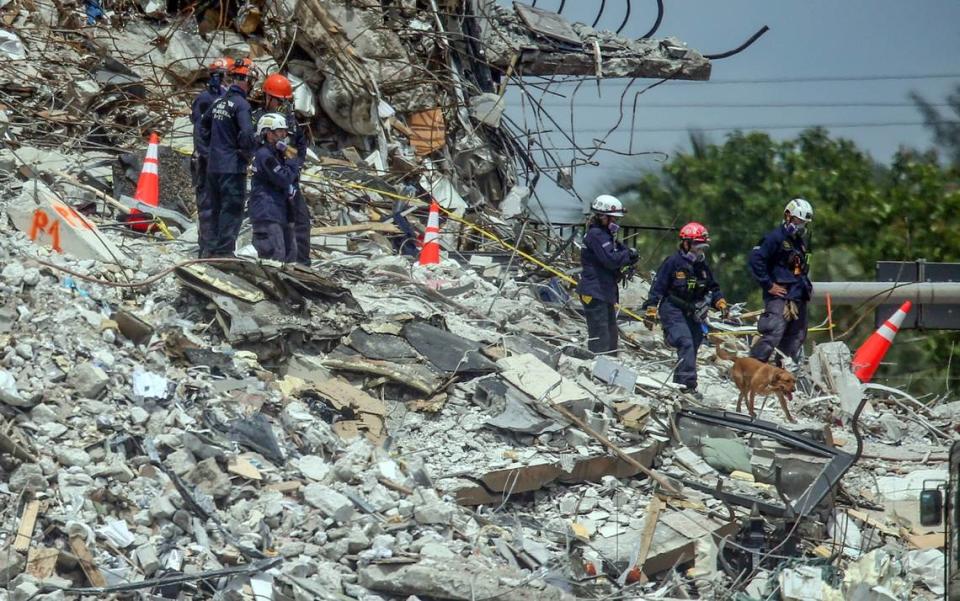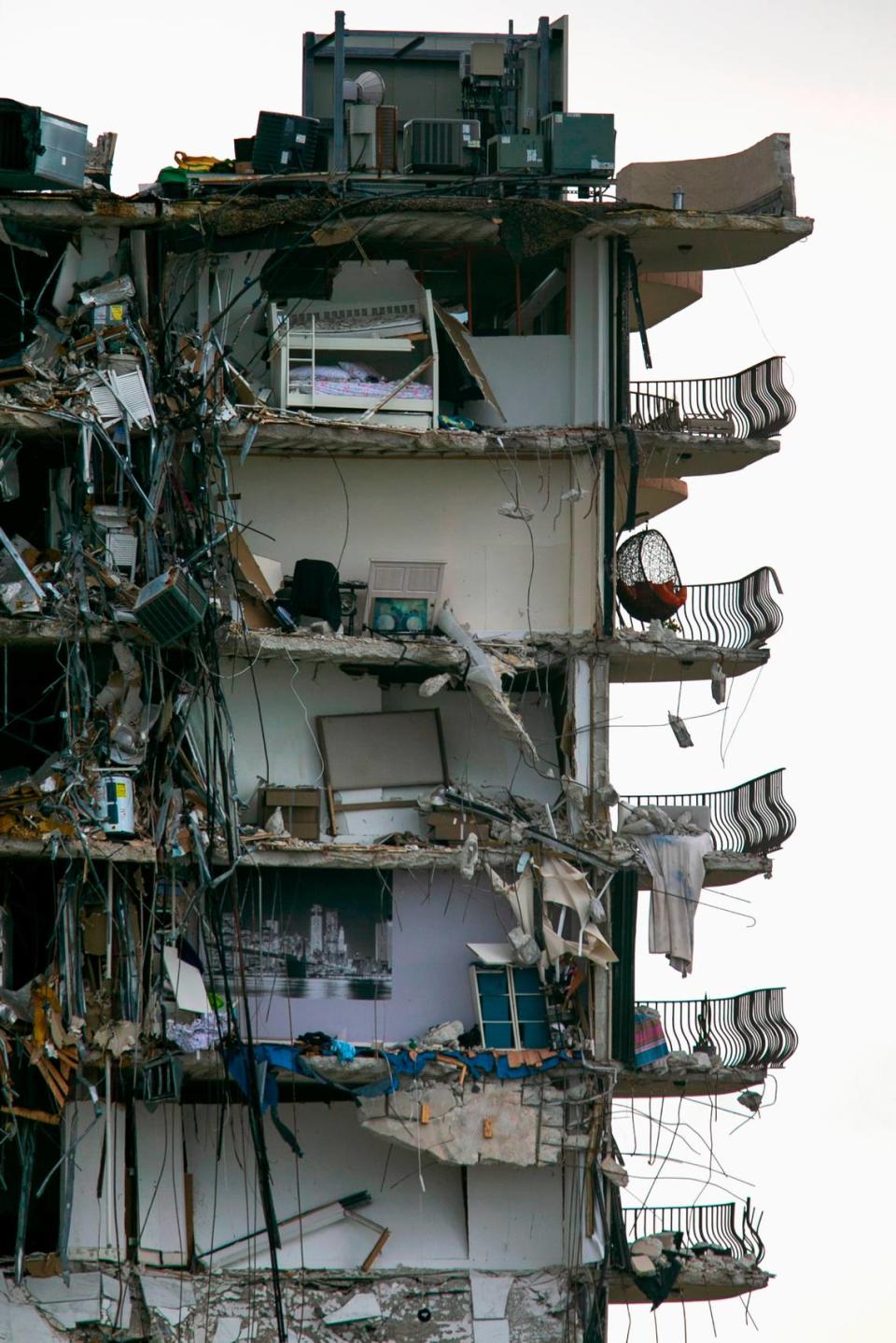Surfside building collapse may have a ‘jarring’ effect on Miami’s condo-buying frenzy
As grim images of rescue workers sifting through the wreckage of the Champlain South Tower circulate around the world, Miami’s kingpin condo real-estate industry is bracing for a slide.
“In the short-term, the effect of the collapse will be jarring,” said real estate attorney Jesse-Dean Kluger, who said he spent the weekend fielding calls from clients under contract for units in older buildings.
“You’re going to have some pushback from buyers on the closing dates, because why would you close before you have an inspection and a satisfactory report?” he said. “This could be a deal-breaker for some clients.”
Built in 1981, the beachfront Champlain Towers South condo, located at 8777 Collins Ave., partially collapsed on the morning of June 24 shortly after 1:30 a.m. The building was going through its 40-year recertification process. Search and rescue efforts are ongoing.
While the exact cause of the collapse probably won’t be known for at least a year, two suspected contributors — salt air and ocean water — are cause for concern for would-be buyers of waterfront condos in older buildings.

In the short-term, at least, some experts say they expect the brakes to slam on what has been a county-wide sales bonanza.
“At the very least, “people are being more sensitive to association fees and checking the financial health of the association,” said Ron Shuffield, president and CEO of Berkshire Hathaway HomeServices EWM Realty. “These 40-year recertifications are now something that everyone is aware of, instead of just the industry. Buyers are also looking more closely to the construction of the building.”
Increased attention to such detail is a positive development, said Shuffield. But it likely also will lead to higher prices and deter some buyers, say experts.
“Every condo, especially the older ones, are going to want to hire an expert and verify the integrity of their buildings,” said Alex Barthet, managing member of the Barthet Construction Law Firm and publisher of thelienzone.com website.
“These are probably not fully budgeted items, so this will increase the assessments,” Barthet said. “That’s going to send buyers away, because they only have a certain number of dollars to spend, so why spend them on an older building?”
According to the Miami Association of Realtors, sales of existing condos jumped a whopping 286% in May year-over-year, from 563 to 2,176, driven primarily by U.S. buyers from tax-burdened states.
The median sales price of existing condos rose to $325,000, a 25% year-over-year increase, and sales of existing condos priced between $400,000-$600,000 — a range that includes many older waterfront buildings — increased 475.4% to a total of 328 transactions.
The Champlain Towers South, where property records show a total of 14 units were sold over the last three years, was part of the sales boom. Condos in the town of Surfside, may be particularly hard hit for the next year, especially in older buildings, said Ana Bozovic, founder of brokerage and consulting firm Analytics Miami.
Buildings located near the collapse site may be most affected. Bozovic said resale prices might drop for the ultra luxury Eighty Seven Park, which is adjacent to the site of the collapse and currently has seven units for sale priced between $2 million-$11 million.
“Who wants to buy something overlooking this collapse? People died there,” she said. “People don’t want to look at the site.”
“When 9/11 happened, it affected the lower Manhattan area,” she said. “It’s going to be the same thing here.”
Buyer hesitation also may affect newer buildings, say experts.
Such was the case for an attorney whose clients were scheduled to close on a Bal Harbour condo the day after the Surfside collapse. “They got cold feet, even though the building where they were buying is only three years old,” said the lawyer, who declined to be named. “They just needed a minute to hear more about what happened at the Champlain Tower. A lot of people with active contracts can delay their closings, but they can’t pull out because they would lose their deposits. They’re stuck.”
Inspections underway
Miami-Dade County and the city of Miami Beach have started doing visual inspections and audits of buildings nearing or at their 40-year recertification process, which is required by county law. The city of Miami has gone further, requiring inspections of all buildings 40 years and older that are six stories or taller. The city has given condo associations a 45-day deadline to provide letters detailing the condition of their buildings signed by licensed structural engineers.
But the enforcement boost hasn’t eased buyer concerns.
“The question is, does being able to walk out on the sand surpass the value of safety?” said real estate analyst Jack McCabe. “What I thought was going to be paradise could now be a danger.
“This collapse is the tip of the iceberg,” McCabe said. There are a lot of other buildings affected by sea level rise and hurricanes that are 40-50 years old, that have not been well maintained, and that have put off special assessments” — that can run into millions.

Favorable pricing has been the chief attraction of older buildings.
“It comes back to affordability,” said Dan Kodsi, CEO of the Miami-based development firm Royal Palms Companies, which developed the Paramount Miami Worldcenter tower. “A lot of people live in those older buildings because they can afford it and still get to live by the water.”
But repairs can diminish the differential.
“Getting hit with a huge assessment bill is going to become a bigger factor in the minds of buyers,” McCabe said. “It could be a much more costly endeavor buying an existing unit than it was in the past.”
Age matters
The numbers tell the story.
According to the real estate firm Condovulturesrealty.com, some 1,660 units in buildings on the barrier islands built before 2000 — or before Florida’s building code was strengthened to its current standard — currently are listed for sale, with an average price per unit of $589,692. During the first three months of 2021, 779 sales were closed at an average price of $487,384. Currently 491 units are under contract at an average price of $484,821.
In comparison, the current 1,241 active listings of condos in buildings on the barrier islands built after 2000 have an average asking price of $3,141,845 — a price tag beyond the reach of all but the wealthy.
The gap likely will widen.
“What you’re going to see is anything built before 2000 is going to suffer and [drop] their prices,” said Peter Zalewski, co-founder of Condo Vultures. “We have always told our clients not to look at anything built before then. Right now the system is stacked against any due diligence by the buyer. The associations are very private, and they’re not going to share any information that might impact pricing. They give the condo docs, and in three days your offer is locked in by default according to state law.”
According to Zalewski, there were 139 towers fronting the Atlantic Ocean in Miami-Dade County as of November 2019. Of those, only 60 were built between 2000-2019. The other 79 towers were built between 1930-1999.

While waterfront has long been considered prime territory, inland locations have been gaining favor as waterfront prices soar and climate change becomes a greater concern. A recent study of “climate gentrification” in Miami-Dade showed home buyers and renters are increasingly choosing properties on higher-elevation land, most of which happens to be in primarily Black and Hispanic neighborhoods.
The collapse may speed the inland migration. Cordelia Anderson, founder of the Miami-based I Heart Real Estate LLC brokerage firm, said one of her prospective condo buyers from New York is now considering moving her search more inland, expressing concern about the structural integrity of coastal buildings and sea level rise.
Falling prices?
The seemingly inevitable price drop of older condos in beachfront locations isn’t just a problem for their owners and brokers. According to the Miami-Dade County Property Appraiser, the county is poised to collect more than $94 billion in 2020 taxes from condominium owners — money that goes to everything from schools and police and fire services to infrastructure repairs and maintenance.
If prices of older condos take a nosedive, all Miami-Dade residents will feel the pinch, since taxes are calculated by property values.
But if prices drop far enough in older buildings to make selling too much of a loss for the owner, there’s another possible scenario that could eliminate the problem altogether, said Alicia Cervera, chairman and principal of Cervera Real Estate: Condo termination, in which owners decide to sell the entire building to a developer interested in building something new at the location.
“When you sell an entire building in a triple-A location to a developer, you get a much better price for your condo,” she said. “It may be that some associations are not doing the repairs because they simply can’t afford it. Selling to a developer could be a solution for the owners and would result in the buildings being taken down before they become unlivable. It’s a good exit strategy for a lot of condo owners.”

